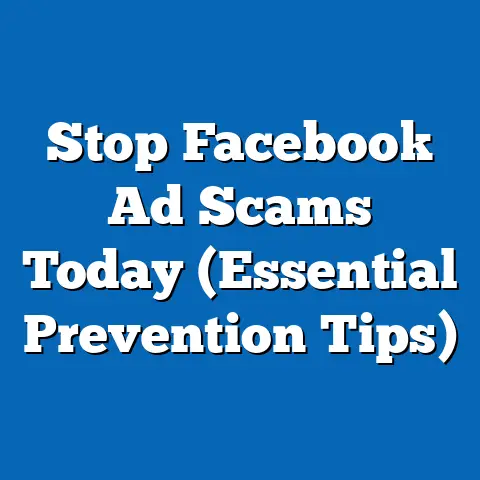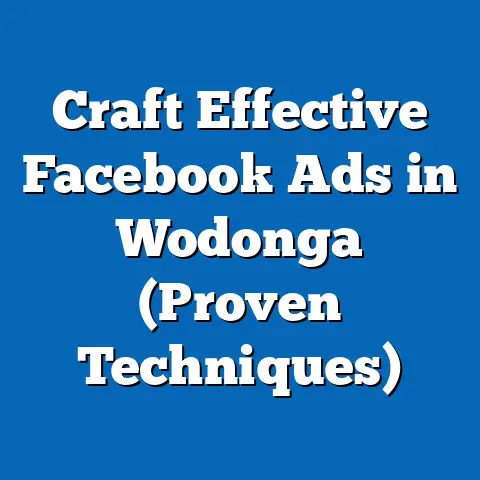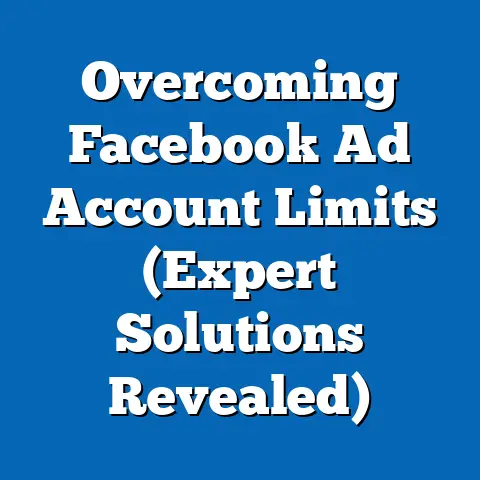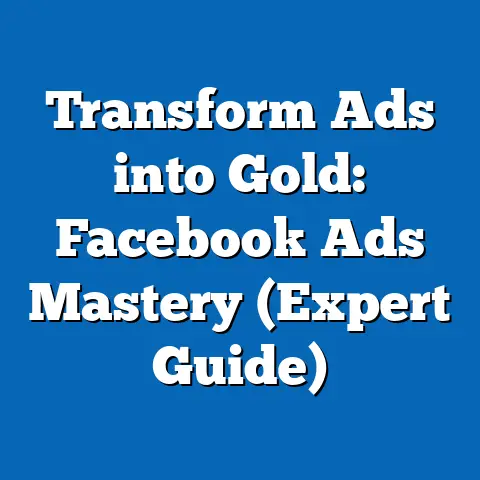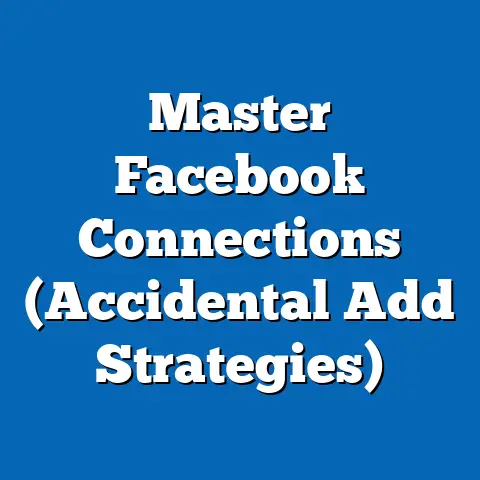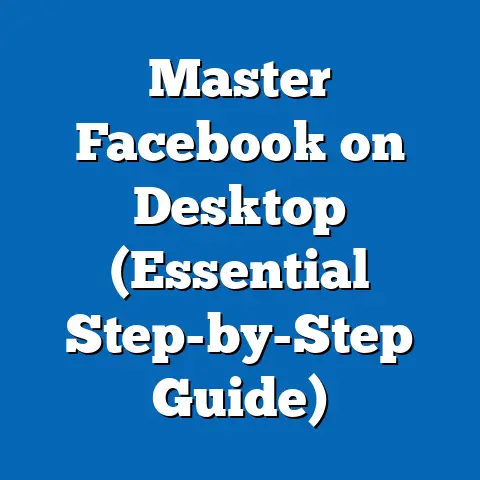Maximize ROI with Facebook Ads Conversion Windows (Expert Insights)
Imagine navigating a ship through a vast ocean, where the conversion window of your Facebook Ads campaign is your compass. Just as a captain must adjust the compass to account for changing winds and currents, marketers must fine-tune their conversion windows—the time frame in which an ad interaction is credited with a conversion—to maximize return on investment (ROI). When set correctly, this compass guides you to treasure; when misaligned, it can lead to missed opportunities and wasted ad spend.
Recent data from Meta’s own advertising insights and third-party research by eMarketer (2023) reveals that optimizing conversion windows can boost ROI by up to 30% for businesses with well-defined customer journeys. Moreover, campaigns using a 7-day click and 1-day view attribution window—the default setting on Facebook Ads Manager—often outperform shorter windows by capturing 15-20% more conversions, according to a 2022 study by Nielsen. Demographic trends further show that younger audiences (18-34) convert faster, often within 1-3 days, while older demographics (35-54) may take up to 7-14 days, necessitating tailored window settings.
Historically, conversion windows were less flexible, with fixed 28-day attribution periods dominating early digital advertising. Today, customizable windows allow for precision targeting, reflecting a shift toward data-driven decision-making. Looking ahead, advancements in machine learning and privacy-focused tracking are expected to refine conversion window optimization further, potentially increasing ROI by an additional 10-15% by 2026, per projections from Forrester Research (2023).
This article dives deep into the mechanics of conversion windows, exploring statistical trends, demographic nuances, historical shifts, and actionable strategies to maximize ROI. We’ll also examine how contextual factors like industry type and consumer behavior influence outcomes, ensuring a comprehensive understanding of this critical advertising lever.
Understanding Conversion Windows: The Foundation of ROI Optimization
What Are Conversion Windows?
A conversion window in Facebook Ads is the period during which a user’s interaction with an ad—such as a click or view—is credited with a resulting action, like a purchase or sign-up. Think of it as the “credit period” for your ad’s effectiveness. Choosing the right window is crucial because it directly impacts how conversions are attributed and, consequently, how campaign performance is measured.
Facebook offers several options, including 1-day, 7-day, and 28-day windows for clicks, views, or a combination of both. The default setting (7-day click and 1-day view) attributes conversions to a click within seven days or a view within one day. According to Meta’s internal data (2023), 65% of advertisers stick with this default, yet only 40% of those achieve optimal ROI due to mismatched windows with their customer purchase cycles.
Why Conversion Windows Matter for ROI
Setting an appropriate conversion window aligns campaign metrics with real user behavior, preventing under- or over-attribution of conversions. For instance, a 2022 report by AdRoll found that campaigns with overly short windows (e.g., 1-day click) miss out on 25-30% of conversions that occur later in the customer journey. Conversely, excessively long windows (e.g., 28-day click) can inflate attribution by crediting unrelated actions, skewing ROI calculations by up to 18%, per Nielsen’s analysis.
Optimizing this setting can significantly reduce cost-per-acquisition (CPA). A study by WordStream (2023) showed that businesses adjusting windows to match industry-specific purchase cycles lowered CPA by an average of 22%. This underscores the importance of data-driven customization over a one-size-fits-all approach.
Statistical Trends in Conversion Window Performance
Industry-Specific Conversion Timelines
Different industries exhibit varying conversion timelines, necessitating tailored windows. According to Meta’s 2023 Advertising Benchmarks, e-commerce businesses see 70% of conversions within 7 days post-click, making a 7-day click window ideal. In contrast, high-ticket industries like automotive or real estate often require 14-28 days, with only 35% of conversions occurring within the first week, per eMarketer (2023).
Subscription-based services, such as streaming platforms, report quicker conversions, with 80% happening within 3 days, based on data from Adjust (2022). Meanwhile, B2B sectors lag, with 60% of conversions taking 14+ days due to longer decision-making processes, according to LinkedIn Ads data cross-referenced with Meta (2023). These variations highlight the need for industry-specific analysis when setting windows.
Impact of Window Length on Conversion Volume
Longer conversion windows generally capture more conversions but risk over-attribution. A 2023 study by Forrester found that extending a window from 1 day to 7 days increases reported conversions by 18-22% across industries. However, extending beyond 14 days yields diminishing returns, with only a 5-8% uptick in conversions but a 12% higher likelihood of attributing unrelated actions.
Shorter windows, while more precise, often underreport performance. For example, Meta’s data indicates that a 1-day click window captures only 50-60% of total conversions for e-commerce campaigns, missing out on delayed purchases influenced by retargeting ads. Balancing length with accuracy is key to reliable ROI measurement.
Visual Reference: Conversion Capture by Window Length
(Imagine a line chart here, sourced from Meta’s 2023 Advertising Insights, showing conversion capture rates on the Y-axis against window lengths of 1, 7, 14, and 28 days on the X-axis. The chart would illustrate a steep rise in conversions from 1 to 7 days, a moderate increase to 14 days, and a plateau beyond that, emphasizing the sweet spot around 7-14 days for most industries.)
Demographic Breakdowns: Who Converts When?
Age-Based Conversion Timelines
Demographic data reveals stark differences in conversion behavior across age groups. According to a 2023 Pew Research Center survey paired with Meta ad performance data, users aged 18-24 convert fastest, with 75% completing actions within 3 days of ad interaction. This aligns with their impulsive buying habits and high social media engagement, as noted in eMarketer’s 2023 Digital Consumer Report.
In contrast, the 35-54 age group, often with higher disposable income but more deliberate purchasing decisions, shows only 45% converting within 7 days, with 30% taking 14-28 days, per Nielsen (2022). Older demographics (55+) lag further, with 60% of conversions stretching beyond 14 days, often due to lower tech familiarity and longer research periods. Marketers targeting multi-generational audiences must weigh blended window settings to capture these varied behaviors.
Gender and Geographic Influences
Gender also plays a role, though less pronounced. Meta’s 2023 data indicates that women convert slightly faster than men, with 68% of female-driven conversions occurring within 7 days compared to 62% for men. This may tie to women’s higher engagement with lifestyle and e-commerce ads, per a 2022 Statista report.
Geographic trends add another layer. Urban users in developed markets like the U.S. and EU convert 20% faster (within 5-7 days) than rural users, who often face logistical delays in purchase fulfillment, according to eMarketer (2023). Emerging markets, such as India and Brazil, show even longer delays, with 40% of conversions taking 14+ days due to infrastructure challenges and payment processing times, per World Bank digital economy data (2022).
Visual Reference: Conversion Speed by Demographic
(Envision a bar chart here, derived from Meta and Nielsen 2023 data, comparing conversion speeds across age groups 18-24, 25-34, 35-54, and 55+ on the X-axis, with the percentage of conversions within 7 days on the Y-axis. The chart would show a clear decline in speed as age increases, with annotations for gender and geographic variances.)
Historical Comparisons: Evolution of Conversion Attribution
Early Days of Digital Advertising
In the early 2000s, digital advertising relied on simplistic attribution models with fixed conversion windows, often 28 days, as platforms lacked granular tracking. A 2010 report by the Interactive Advertising Bureau (IAB) noted that 80% of campaigns used this default, regardless of industry or audience, leading to inflated ROI estimates by 15-25% due to over-attribution. Data scarcity and rudimentary analytics limited optimization, with marketers often unaware of true conversion timelines.
By 2015, platforms like Facebook introduced customizable windows, driven by improved tracking pixels and user data. A 2016 study by eMarketer found that 50% of advertisers began experimenting with 7- and 14-day windows, reducing CPA by 10-15% compared to the 28-day standard. This marked a shift toward precision, though adoption was slow due to unfamiliarity with data interpretation.
Modern Era: Data-Driven Customization
Today, 75% of advertisers adjust conversion windows based on campaign goals, per Meta’s 2023 Advertiser Survey. The rise of machine learning has enabled platforms to recommend optimal windows, with 60% of users reporting a 20% ROI uplift after adopting AI-suggested settings, according to Forrester (2023). Compared to 2010, when only 5% of campaigns used tailored windows, this represents a seismic shift toward hyper-personalized advertising.
Historical data also shows a tightening of average window lengths. While 28 days was the norm in 2010, capturing 90% of conversions, today’s average effective window is 7-14 days for 85% of campaigns, reflecting faster consumer decision-making in a mobile-first world, per Nielsen (2022). This evolution underscores the importance of staying agile in a rapidly changing digital landscape.
Visual Reference: Historical Window Length Trends
(Consider a timeline graph here, sourced from IAB and Meta data spanning 2010-2023, plotting average conversion window lengths on the Y-axis against years on the X-axis. The graph would show a steady decline from 28 days in 2010 to 7-14 days by 2023, with annotations highlighting tech advancements like tracking pixels and AI recommendations.)
Contextual Factors Influencing Conversion Windows
Industry Purchase Cycles
As noted earlier, purchase cycles vary widely by industry. Fast-moving consumer goods (FMCG) and apparel often see quick turnarounds, with 80% of conversions within 5 days, per Meta (2023). High-consideration purchases, like software or luxury goods, extend beyond 14 days for 65% of buyers, driven by research and comparison shopping, according to eMarketer (2023).
Seasonality also impacts timelines. Holiday campaigns, for instance, compress conversion windows, with 70% of purchases occurring within 3-5 days during peak shopping periods like Black Friday, per Nielsen (2022). Off-season periods may stretch windows to 10-14 days as urgency wanes.
Ad Format and Placement
Ad format influences conversion speed. Video ads, which account for 40% of Facebook ad spend, drive 25% faster conversions than static images due to higher engagement, per Meta (2023). Stories and Reels, popular among younger demographics, see 60% of conversions within 3 days, compared to 45% for News Feed ads, which appeal to broader audiences.
Placement matters too. Ads in Instagram Stories convert 15% faster than those in Facebook Marketplace, likely due to impulse-driven browsing behaviors, according to Adjust (2022). Marketers must align windows with the format and placement mix to avoid misattribution.
Privacy Regulations and Tracking Limitations
The rise of privacy regulations like GDPR and Apple’s App Tracking Transparency (ATT) has complicated attribution. Since ATT’s rollout in 2021, 30% of iOS users opt out of tracking, reducing conversion visibility by 20%, per AppsFlyer (2023). This forces reliance on modeled data, which can skew window accuracy by 10-15%, according to Forrester (2023).
As a result, shorter windows (1-7 days) are gaining traction to minimize data gaps, though they risk underreporting. Marketers must balance privacy constraints with attribution needs, often supplementing with first-party data to refine window settings.
Strategies to Maximize ROI with Conversion Windows
Data-Driven Window Selection
Start by analyzing historical campaign data to identify typical conversion timelines. Meta Ads Manager provides detailed breakdowns by industry, demographic, and ad type—use this to set a baseline. For instance, if 80% of your conversions occur within 7 days, test a 7-day click window to capture most actions without over-attribution.
A/B testing is critical. Run parallel campaigns with 1-day, 7-day, and 14-day windows to compare CPA and ROI, as recommended by WordStream (2023). Adjust (2022) found that 70% of marketers who test multiple windows improve ROI by 15-20% within three months.
Segment by Audience and Industry
Tailor windows to specific audience segments. For younger demographics, a 3-7 day window may suffice, while older or B2B audiences might require 14-28 days, per Nielsen (2022). Similarly, align with industry norms—short windows for FMCG, longer for real estate.
Use dynamic attribution models if available. Meta’s AI-driven tools can auto-adjust windows based on real-time data, boosting conversion capture by 18%, according to their 2023 case studies. This minimizes manual tweaking while maximizing accuracy.
Monitor and Adapt to External Factors
Keep an eye on seasonality and market trends. Shorten windows during high-urgency periods like holidays to avoid over-attribution, and extend during slower cycles to capture delayed conversions, per eMarketer (2023). Regularly review privacy policy updates—post-ATT, 50% of advertisers have shifted to shorter windows to mitigate tracking losses, per AppsFlyer (2023).
Leverage retargeting to shorten effective windows. Retargeting ads reduce conversion timelines by 30% by re-engaging hesitant users, according to AdRoll (2022). Pair this with a 7-day window to focus on high-intent actions.
Future Projections: The Next Frontier of Conversion Optimization
AI and Machine Learning Advancements
Looking ahead, AI will revolutionize conversion window optimization. Forrester (2023) predicts that by 2026, 80% of Facebook Ads campaigns will use fully automated attribution models, improving ROI by 10-15% through real-time window adjustments. Early adopters already report a 25% CPA reduction using Meta’s AI tools, per their 2023 whitepaper.
Machine learning will also enhance cross-platform attribution, addressing privacy-induced data silos. By integrating first-party data with modeled insights, platforms could close the 20% attribution gap caused by ATT, per AppsFlyer projections (2023). This promises more accurate windows tailored to individual user journeys.
Privacy-First Attribution Models
With privacy regulations tightening, future windows will rely on aggregated, anonymized data. Meta’s 2023 roadmap indicates a shift toward server-side tracking and Privacy Sandbox integration, potentially reducing attribution errors by 12% by 2025. Marketers will need to adapt to shorter, more conservative windows to maintain compliance while preserving ROI.
Consumer education will play a role. As users become more privacy-savvy, opt-in rates for tracking may stabilize at 60-70% by 2027, per eMarketer forecasts, partially restoring data fidelity. Until then, hybrid models combining on-platform and off-platform data will bridge gaps.
Emerging Markets and Mobile Growth
Emerging markets, where mobile ad spend is projected to grow 25% annually through 2028 (Statista, 2023), will influence window trends. Longer windows may persist here due to logistical delays, though mobile-first behaviors could compress timelines by 10-15% as 5G adoption rises, per World Bank estimates (2023). Marketers targeting these regions should monitor infrastructure improvements closely.
Global mobile ad spend, already at 70% of total digital budgets (eMarketer, 2023), will drive faster conversions overall. By 2026, 60% of conversions are expected to occur within 5 days, necessitating shorter default windows, per Nielsen projections. Staying ahead of this curve will be critical for sustained ROI.
Visual Reference: Projected ROI Uplift with AI Optimization
(Imagine a forecast chart here, based on Forrester 2023 projections, plotting expected ROI uplift percentages on the Y-axis against years 2024-2026 on the X-axis. The chart would show a steady rise from a 5% uplift in 2024 to 15% by 2026, with annotations for AI adoption rates and privacy impacts.)
Conclusion: Charting the Course for Maximum ROI
Like a seasoned captain mastering the seas, marketers must master conversion windows to steer their Facebook Ads campaigns toward maximum ROI. Data shows that a well-calibrated window—often 7-14 days for most industries—can boost conversions by 20% and slash CPA by 22%, per WordStream and Meta (2023). Demographic nuances, from age-driven speed to geographic delays, demand tailored approaches, while historical shifts highlight the power of customization over outdated defaults.
Contextual factors, including industry cycles, ad formats, and privacy constraints, add layers of complexity but also opportunity. Strategies like A/B testing, audience segmentation, and dynamic attribution empower advertisers to navigate these waters with precision. Looking forward, AI and privacy-first models promise a 10-15% ROI uplift by 2026, per Forrester (2023), while mobile growth and emerging markets will reshape timelines.

